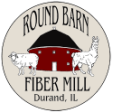Preparing Fiber For Further Processing
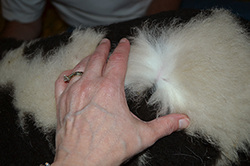
Evaluating
When your fiber arrives at Round Barn Fiber Mill, it is first of all evaluated: we open your package and weigh your fiber. We also look the fiber over carefully to determine how much, if any, skirting is needed. If your fleece contains too much manure and vegetable matter to allow further processing in this condition, we'll contact you to discuss additional needed services (such as skirting and tumbling). Occasionally, we may need to send fiber back to you if we feel its condition is too poor to be professionally processed.
When your fiber arrives at Round Barn Fiber Mill, it is first of all evaluated: we open your package and weigh your fiber. We also look the fiber over carefully to determine how much, if any, skirting is needed. If your fleece contains too much manure and vegetable matter to allow further processing in this condition, we'll contact you to discuss additional needed services (such as skirting and tumbling). Occasionally, we may need to send fiber back to you if we feel its condition is too poor to be professionally processed.
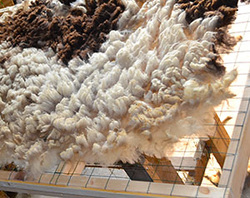
Skirting
"Skirting" is a fancy term meaning to go over a fleece and remove as much foreign matter as possible by hand. Things to removed include manure tags, soiled edges, second cuts (short locks of fiber created when the shearer goes over the animal's body a second time during shearing), foreign objects (like wire/sticks/etc.), and vegetable matter (like hay, straw, burrs, stickers, etc.)
As noted above, it is your responsibility to skirt your fleeces thoroughly before sending them to be processed by us. If the fleece has excessive manure or vegetable matter, we will need to charge for additional skirting.
"Skirting" is a fancy term meaning to go over a fleece and remove as much foreign matter as possible by hand. Things to removed include manure tags, soiled edges, second cuts (short locks of fiber created when the shearer goes over the animal's body a second time during shearing), foreign objects (like wire/sticks/etc.), and vegetable matter (like hay, straw, burrs, stickers, etc.)
As noted above, it is your responsibility to skirt your fleeces thoroughly before sending them to be processed by us. If the fleece has excessive manure or vegetable matter, we will need to charge for additional skirting.

Tumbling
"Tumbling" is an optional service in which fiber is placed in a machine called a tumbler and, well, tumbled, to remove dirt/dust/vegetable matter, etc. The tumbling process is particularly helpful for camelid fiber (such as llama and alpaca), so we routinely tumble all camelid fiber (after skirting and before washing). Occasionally, a wool fleece may benefit from tumbling as well.
"Tumbling" is an optional service in which fiber is placed in a machine called a tumbler and, well, tumbled, to remove dirt/dust/vegetable matter, etc. The tumbling process is particularly helpful for camelid fiber (such as llama and alpaca), so we routinely tumble all camelid fiber (after skirting and before washing). Occasionally, a wool fleece may benefit from tumbling as well.
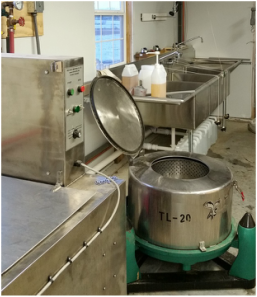
Washing
After skirting, all fiber must be washed. We use an industrial fiber washing system specifically designed for cleaning animal fiber. We strive to use biodegradable cleansing agents that will not harm your fiber or the environment.
Some fiber is sent to us pre-washed by the customer. We reserve the right to determine if such fiber needs re-washing to be suitable for carding on our equipment.
After skirting, all fiber must be washed. We use an industrial fiber washing system specifically designed for cleaning animal fiber. We strive to use biodegradable cleansing agents that will not harm your fiber or the environment.
Some fiber is sent to us pre-washed by the customer. We reserve the right to determine if such fiber needs re-washing to be suitable for carding on our equipment.
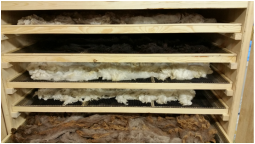
Drying
Once the fiber has been washed, we spread it out to dry on our drying racks, where a built-in fan circulates the air to speed up the drying process. Most often, the fiber completely dries overnight.
Once the fiber has been washed, we spread it out to dry on our drying racks, where a built-in fan circulates the air to speed up the drying process. Most often, the fiber completely dries overnight.
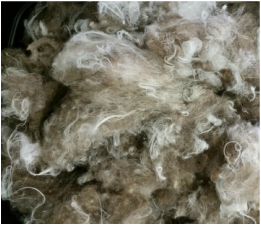
Picking
Next, your fiber is removed from the drying racks and placed into our picker, a machine that looks something like a medieval torture instrument. The sharp tines on the picker open up the fiber, remove some additional vegetable matter, and prepare the fiber for carding. For fibers that we feel are too fine to be picked by machine (for example, some very fine fibers), we pick the fiber by hand before carding.
Next, your fiber is removed from the drying racks and placed into our picker, a machine that looks something like a medieval torture instrument. The sharp tines on the picker open up the fiber, remove some additional vegetable matter, and prepare the fiber for carding. For fibers that we feel are too fine to be picked by machine (for example, some very fine fibers), we pick the fiber by hand before carding.
